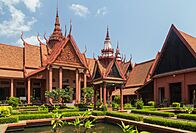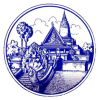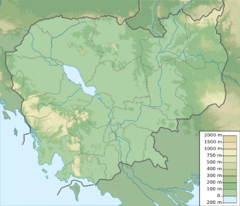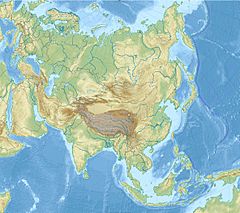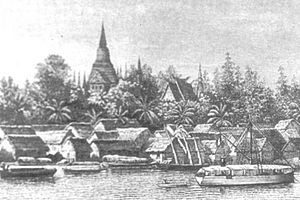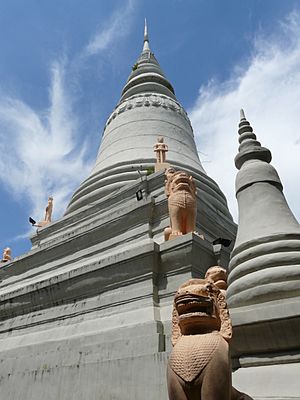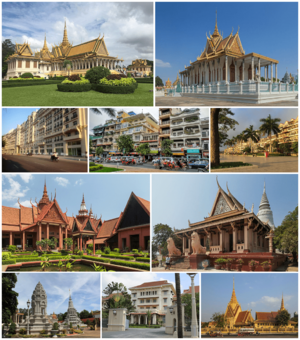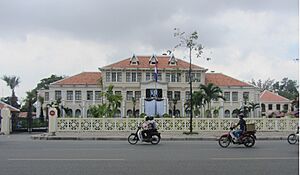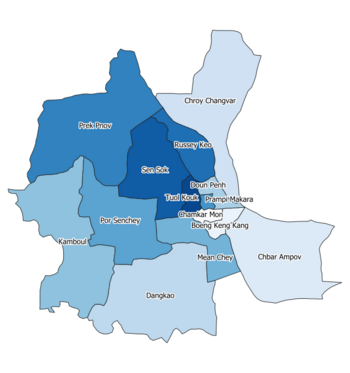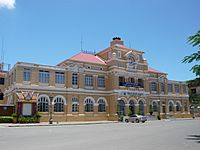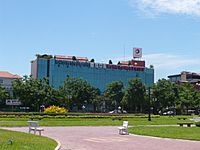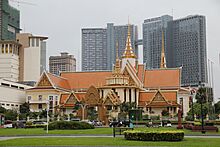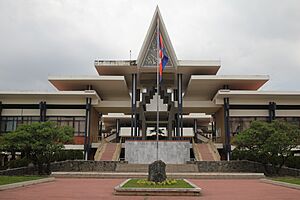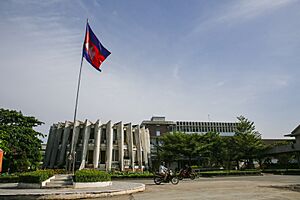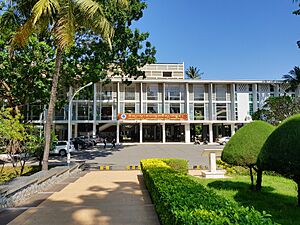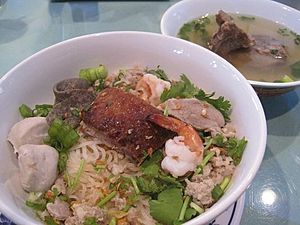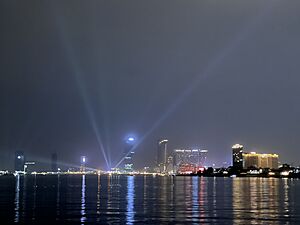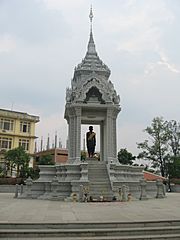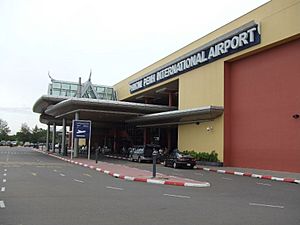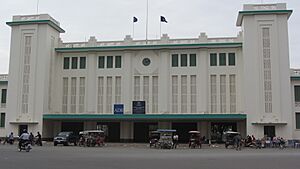Phnom Penh facts for kids
Quick facts for kids
Phnom Penh
ភ្នំពេញ
|
||
|---|---|---|
|
||
|
Phnom Penh skyline
Independence Monument
Royal Palace of Cambodia
National Museum of Cambodia
Wat Phnom
|
||
|
||
Nickname(s):
|
||
| Country | Cambodia | |
| Settled | 5th century | |
| Founded | 1372 | |
| Capital status | 1434–1497 | |
| Capital re-established | 1865 | |
| Named for | Wat Phnom and Lady Penh | |
| Subdivisions | 14 khans | |
| Government | ||
| • Type | Municipal council | |
| Area | ||
| • Capital city and |
679 km2 (262 sq mi) | |
| • Metro | 3,858 km2 (1,490 sq mi) | |
| Area rank | 24th | |
| Elevation | 11.89 m (39.01 ft) | |
| Population
(2024 census)
|
||
| • Capital city and |
||
| • Rank | 1st | |
| • Density | 3,361/km2 (8,700/sq mi) | |
| • Density rank | 1st | |
| • Metro | 3,483,532 | |
| Demonym(s) |
|
|
| Time zone | UTC+07:00 (ICT) | |
| Area code(s) | +855 (023) | |
| HDI (2022) |
|
|
| Phnom Penh | |
|---|---|
| Khmer name | |
| Khmer | ភ្នំពេញ
UNGEGN: Phnum Pénh GD: Phnum Penh ALA-LC: Bhnaṃ Beñ IPA: [pʰnomˈpɨɲ] |
Phnom Penh is the capital and largest city of Cambodia. It has been the country's capital since 1865. Today, it is Cambodia's most important city for politics, economy, industry, and culture. The city's name comes from Wat Phnom, a Buddhist temple, and Lady Penh, who is said to have founded the city.
Phnom Penh is located where the Tonlé Sap and Mekong rivers meet. It is also the starting point of the Bassac River. The city is home to Cambodia's monarchy, based at the Royal Palace.
The city was founded in 1372. It became the capital in 1434 after Angkor Thom fell. It remained the capital until 1497. Phnom Penh became the capital again during the time when France ruled Cambodia. It grew a lot and became very modern before the 1970s. People called it the "Pearl of Asia" because of its beautiful buildings.
In the 1960s and 1970s, many people moved to Phnom Penh. They were seeking safety from the civil war and American bombings. In 1975, the Khmer Rouge forced everyone to leave the city. Many people suffered greatly during this time. Phnom Penh was mostly empty until forces supported by Vietnam took the city in 1979.
After this, the city was rebuilt. Its buildings and services improved with help from other countries. By 2019, over 2 million people lived there. This was about 14% of Cambodia's total population.
The area around Phnom Penh includes Ta Khmau city and parts of Kandal province. The city used to be a center for making textiles and medicines. It also processed rice. Many important schools, colleges, and universities are in Phnom Penh. Its cultural places and events make it a popular spot for visitors.
Phnom Penh has hosted many big events. These include the ASEAN Summit several times. It also hosted the Southeast Asian Games and the ASEAN Para Games in 2023. Phnom Penh will host the Asian Youth Games in 2029. This will be the first time for a Cambodian city.
Contents
- Understanding the Name of Phnom Penh
- A Look at Phnom Penh's Past
- Phnom Penh's Location and Environment
- How Phnom Penh is Governed
- Phnom Penh's Population and People
- Phnom Penh's Economy
- Learning and Education in Phnom Penh
- Phnom Penh's Culture and Traditions
- Phnom Penh's Buildings and Design
- Media and News in Phnom Penh
- Sports in Phnom Penh
- Getting Around Phnom Penh
- Phnom Penh's Water Supply
- Cities that are Friends with Phnom Penh
- Famous People from Phnom Penh
- More to Explore
- See also
Understanding the Name of Phnom Penh
Phnom Penh means "Penh's hill." The name comes from Wat Phnom, which means "hill temple." Some say it also relates to the ancient Funan Kingdom. This kingdom existed from the 1st to the 7th century AD. It was an early kingdom in Southeast Asia.
A legend says that in 1372, a rich woman named Penh found a Koki tree floating in the Tonlé Sap River. Inside the tree were four bronze Buddha statues and a stone statue of Vishnu. Lady Penh asked villagers to build up a hill. She then used the Koki wood to build a temple on the hill. This temple was for the Buddha statues. She also built a shrine for the Vishnu statue. The temple became known as Wat Phnom Daun Penh. Today, it is called Wat Phnom. It is a small hill about 27 metres (89 ft) high.
Phnom Penh's old official name was Krong Chaktomuk Serei Mongkol. This means "city of Brahma's faces." A shorter name was Krong Chaktomuk, meaning "city of four faces." King Ponhea Yat gave it a very long official name. This name roughly means "the place of four rivers that gives happiness and success to the Khmer Kingdom." It also means "the highest leader's city" and "impregnable city of the God Indra of the great kingdom."
A Look at Phnom Penh's Past
People believe Phnom Penh was first settled around the 5th century AD. This is based on discoveries of old pottery sites. One site, Choeung Ek, was a large pottery center. It made special ceremonial pots from the 5th to 13th centuries. Archaeologists found a large community there. It had a circular earth wall, 740 metres (2,430 ft) wide and 4 metres (13 ft) high. This wall was built in the 11th century. Other old village structures and temples were also found.
The legend of Lady Penh tells how the city was founded. She lived at Chaktomuk, where Phnom Penh is now. This was in the late 14th century. The Khmer capital was then at Angkor, about 350 km (217 mi) north. Lady Penh found a floating koki tree with Buddha and Vishnu statues inside.
People saw this discovery as a special blessing. Some thought it meant the capital should move to Phnom Penh. Lady Penh built a small hill and a shrine for the statues. This place is now Wat Phnom. "Phnom" means "hill" in Khmer. So, Penh's hill gave the area its name.
Phnom Penh first became the capital after Ponhea Yat moved it from Angkor Thom. This happened after Angkor was attacked by Siam. There is a stupa behind Wat Phnom. It holds the remains of Ponhea Yat and his family. It also has Buddhist statues from the Angkor era. In the 17th century, Japanese and Portuguese communities lived near Phnom Penh.
Phnom Penh was the capital for 73 years, from 1432 to 1505. Then, kings moved the capital many times. This was due to conflicts among royal families.
In 1866, under King Norodom I, Phnom Penh became the permanent capital. The current Royal Palace was built then. From 1870, French rulers developed the city. They built hotels, schools, banks, and other public buildings. In 1872, King Norodom hired a French builder. He built 300 brick houses for Chinese traders.
By the 1920s, Phnom Penh was called the "Pearl of Asia." It grew quickly over the next 40 years. Railways were built to Sihanoukville and the airport. Norodom Sihanouk modernized the city's services.
During the Vietnam War, many people came to Phnom Penh. They were seeking safety from fighting. By 1975, the city had 2–3 million people. Most were seeking safety. The Khmer Rouge cut off supplies to the city. It fell on April 17, 1975. The Khmer Rouge forced everyone to leave the city. This was a very difficult time. People were forced to work on farms. Many suffered and died.
Tuol Sleng High School became the S-21 prison camp. People were held and tortured there. The Khmer Rouge leader, Pol Pot, wanted to return to a farming economy. Many educated people were killed. Others died from hunger. The former school is now the Tuol Sleng Genocide Museum. It shows what happened there. Choeung Ek, about 15 kilometers (9 mi) away, was where prisoners were taken to be killed. It is now a memorial.
The Khmer Rouge were driven out of Phnom Penh in 1979. People then began to return. The city started to rebuild. New foreign investments and aid helped. Loans from banks helped fix water supply and roads. In 1998, Phnom Penh's population was 862,000. By 2008, it was 1.3 million. In 2019, it reached over 2.2 million.
Phnom Penh's Location and Environment
Phnom Penh is in the middle-south of Cambodia. The Kandal province surrounds it. The city is on the banks of the Tonlé Sap, Mekong, and Bassac Rivers. These rivers provide fresh water and other natural resources. Phnom Penh is in a typical flood plain area. Even though it is 11.89 metres (39 ft) above the river, flooding can happen during monsoon season. Boeung Kak, a large lake, was filled in 2010 for building projects.
The city covers an area of 678.46 square kilometres (262 sq mi). This includes about 11,401 hectares (28,172 acres) in the city itself. There are also 26,106 ha (64,509 acres) of roads. Farmland in the city covers 34.685 km2 (13 sq mi). Some of this land, 1.476 km2 (365 acres), is used for irrigation.
Phnom Penh's Climate
Phnom Penh has a tropical wet and dry climate. The weather is hot all year. Temperatures usually range from 22 to 35 °C (72 to 95 °F). The weather is affected by tropical monsoons. The southwest monsoon brings wet winds from May to November. This means high temperatures and high humidity. The dry season is from December to April. During this time, night temperatures can drop to 22 °C (72 °F).
| Climate data for Phnom Penh (temperature: 1988–2013, extremes: 1906–2013) | |||||||||||||
|---|---|---|---|---|---|---|---|---|---|---|---|---|---|
| Month | Jan | Feb | Mar | Apr | May | Jun | Jul | Aug | Sep | Oct | Nov | Dec | Year |
| Record high °C (°F) | 36.1 (97.0) |
38.1 (100.6) |
40.0 (104.0) |
40.5 (104.9) |
40.0 (104.0) |
39.2 (102.6) |
37.2 (99.0) |
37.8 (100.0) |
35.5 (95.9) |
36.1 (97.0) |
34.4 (93.9) |
37.2 (99.0) |
40.5 (104.9) |
| Mean daily maximum °C (°F) | 31.6 (88.9) |
33.2 (91.8) |
34.6 (94.3) |
35.3 (95.5) |
34.8 (94.6) |
33.8 (92.8) |
32.9 (91.2) |
32.7 (90.9) |
32.2 (90.0) |
31.4 (88.5) |
31.1 (88.0) |
30.8 (87.4) |
32.9 (91.2) |
| Daily mean °C (°F) | 26.6 (79.9) |
28.0 (82.4) |
29.4 (84.9) |
30.2 (86.4) |
30.0 (86.0) |
29.2 (84.6) |
28.7 (83.7) |
28.5 (83.3) |
28.2 (82.8) |
27.2 (81.0) |
27.1 (80.8) |
26.3 (79.3) |
28.3 (82.9) |
| Mean daily minimum °C (°F) | 21.8 (71.2) |
22.8 (73.0) |
24.3 (75.7) |
25.5 (77.9) |
25.6 (78.1) |
24.9 (76.8) |
24.8 (76.6) |
24.6 (76.3) |
24.4 (75.9) |
24.2 (75.6) |
23.2 (73.8) |
21.9 (71.4) |
24.0 (75.2) |
| Record low °C (°F) | 12.8 (55.0) |
15.2 (59.4) |
19.0 (66.2) |
17.8 (64.0) |
20.6 (69.1) |
21.2 (70.2) |
20.1 (68.2) |
20.0 (68.0) |
21.1 (70.0) |
17.2 (63.0) |
16.7 (62.1) |
14.4 (57.9) |
12.8 (55.0) |
| Average precipitation mm (inches) | 12.1 (0.48) |
6.6 (0.26) |
34.8 (1.37) |
78.8 (3.10) |
118.2 (4.65) |
145.0 (5.71) |
162.1 (6.38) |
182.7 (7.19) |
270.9 (10.67) |
248.1 (9.77) |
120.5 (4.74) |
32.1 (1.26) |
1,411.9 (55.58) |
| Average rainy days (≥ 0.1 mm) | 1.2 | 1.1 | 3.4 | 6.8 | 15.9 | 17.0 | 18.1 | 18.3 | 21.5 | 19.3 | 10.2 | 4.5 | 137.3 |
| Average relative humidity (%) | 73 | 71 | 71 | 73 | 77 | 78 | 80 | 81 | 84 | 84 | 78 | 73 | 77 |
| Mean monthly sunshine hours | 260 | 226 | 267 | 240 | 202 | 192 | 143 | 174 | 129 | 202 | 213 | 242 | 2,490 |
| Source 1: Deutscher Wetterdienst | |||||||||||||
| Source 2: Danish Meteorological Institute (sun, 1931–1960) | |||||||||||||
How Phnom Penh is Governed
Phnom Penh is a special city that acts like a province. It covers 678.46 square kilometres (261.95 sq mi). The city is divided into 14 areas called khans (sections). These khans are then split into 105 sangkats (quarters). And these are further divided into 953 phums (villages). All khans are managed by the Phnom Penh government. Some khans like Dangkao and Russey Keo are on the city's edges.
The city is led by a governor. The governor is in charge of the city's police and urban planning. There is also a first vice governor and five other vice governors. The chief of cabinet manages 27 administrative departments. Each khan also has its own chief.
| Phnom Penh Administrative Sections | |||||
|---|---|---|---|---|---|
| ISO code | Name | Khmer | Quarters | Villages | Population |
| 1201 | Chamkar Mon | ខណ្ឌចំការមន | 5 | 40 | 70,772 |
| 1202 | Doun Penh | ខណ្ឌដូនពេញ | 11 | 134 | 155,069 |
| 1203 | Prampir Makara | ខណ្ឌប្រាំពីរមករា | 8 | 66 | 71,092 |
| 1204 | Tuol Kouk | ខណ្ឌទួលគោក | 10 | 143 | 145,570 |
| 1205 | Dangkao | ខណ្ឌដង្កោ | 12 | 81 | 159,772 |
| 1206 | Mean Chey | ខណ្ឌមានជ័យ | 7 | 59 | 248,464 |
| 1207 | Russey Keo | ខណ្ឌឫស្សីកែវ | 7 | 30 | 274,861 |
| 1208 | Sen Sok | ខណ្ឌសែនសុខ | 6 | 47 | 182,903 |
| 1209 | Pou Senchey | ខណ្ឌពោធិ៍សែនជ័យ | 7 | 75 | 226,971 |
| 1210 | Chroy Changvar | ខណ្ឌជ្រោយចង្វារ | 5 | 22 | 159,233 |
| 1211 | Prek Pnov | ខណ្ឌព្រែកព្នៅ | 5 | 59 | 188,190 |
| 1212 | Chbar Ampov | ខណ្ឌច្បារអំពៅ | 8 | 49 | 164,379 |
| 1213 | Boeng Keng Kang | ខណ្ឌបឹងកេងកង | 7 | 55 | 66,658 |
| 1214 | Kamboul | ខណ្ឌកំបូល | 7 | 93 | 75,526 |
Phnom Penh's Population and People
| Historical population | ||
|---|---|---|
| Year | Pop. | ±% p.a. |
| 1950 | 334,000 | — |
| 1960 | 398,000 | +1.77% |
| 1970 | 457,000 | +1.39% |
| 1975 | 370,000 | −4.14% |
| 1978 | 32,000 | −55.78% |
| 1980 | 189,000 | +143.03% |
| 1985 | 351,000 | +13.18% |
| 1990 | 634,000 | +12.55% |
| 1995 | 925,000 | +7.85% |
| 2000 | 1,284,000 | +6.78% |
| 2005 | 1,677,000 | +5.49% |
| 2010 | 2,101,725 | +4.62% |
| 2019 | 2,129,371 | +0.15% |
As of 2019, Phnom Penh had 2,129,371 people. The city's population density was 3,136 people per square kilometer. The city has grown a lot since 1979. The greater metro area continues to expand.
A 2017 survey showed that most people in Phnom Penh are Khmer (95.3%). About 4% are Chams. The rest (0.7%) are other groups. These include Chinese, Vietnamese, Thai, and others.
The official language is Khmer. However, English and French are also widely used.
Religion in Phnom Penh
Religion in Phnom Penh (2019 census) Buddhism (97.8%) Islam (1.6%) Christianity (0.5%) Animism and Other religions (0.1%)
The main religion in Cambodia is Theravada Buddhism. Over 97.8% of people in Phnom Penh are Buddhists. Chams, people from South Asia, and a small number of Khmers practice Islam. A small percentage of people follow Christianity.
Phnom Penh's Economy
Phnom Penh is Cambodia's main economic hub. It contributes a large part to the country's economy. The city has seen strong economic growth recently. This has led to many new hotels, restaurants, schools, and buildings.
The economy relies on things like clothing, trade, and small businesses. The property market has been growing fast. Tourism is also very important. Many new shopping centers have opened. This makes Phnom Penh a top tourist spot in Southeast Asia. Sisowath Quay is a popular area for tourists. It has many restaurants, bars, and hotels along the Tonle Sap River.
A large new city project, Camko City, is being built. It is worth US$2.6 billion. The city government plans to expand and build new services. This will help with the growing population and economy. Tall buildings are planned for the city's entrance. New roads, canals, and a railway system will connect Camko City and Phnom Penh.
Other big projects include:
- Grand Phnom Penh International City (under construction)
- Gold Tower 42 (construction started again in mid-2018)
- Vattanac Capital Tower
- The Peak
With economic growth, many new shopping places have opened. These include Aeon Mall Phnom Penh and Olympia Mall. Many international brands have also opened stores.
The tallest building in Phnom Penh is Vattanac Capital Tower. It is 188 metres (617 ft) tall. It stands out in the city's skyline. Modern tall buildings are being built all over the city.
The Central Market, Phsar Thmei, is a popular place for tourists. Its yellow buildings have many stalls. They sell jewelry, old coins, clothes, and food. Phsar Thmei is currently being renovated.
Learning and Education in Phnom Penh
Universities and Colleges
Phnom Penh has many universities and colleges. Here are some of them:
| Name | Khmer |
|---|---|
| American University of Phnom Penh | សាកលវិទ្យាល័យអាមេរិកាំងភ្នំពេញ |
| BELTEI International University | សាកលវិទ្យាល័យប៊ែលធីអន្តរជាតិ |
| Cambodia Academy of Digital Technology | បណ្ឌិត្យសភាបច្ចេកវិទ្យាឌីជីថលកម្ពុជា |
| University of Cambodia (UC) | សាកលវិទ្យាល័យកម្ពុជា |
| International University (IU) | សាកលវិទ្យាល័យអន្តរជាតិ |
| École Royale d'Administration (ERA) | សាលាភូមិន្ទរដ្ឋបាល |
| Royal University of Phnom Penh (RUPP) | សាកលវិទ្យាល័យភូមិន្ទភ្នំពេញ |
| Royal University of Law and Economics (RULE) | សាកលវិទ្យាល័យភូមិន្ទនីតិសាស្ត្រ និងវិទ្យាសាស្ត្រសេដ្ឋកិច្ច |
| Royal University of Fine Arts (RUFA) | សាកលវិទ្យាល័យភូមិន្ទវិចិត្រសិល្បៈ |
| Royal University of Agriculture (RUA) | សាកលវិទ្យាល័យភូមិន្ទកសិកម្ម |
| National University of Management (NUM) | សាកលវិទ្យាល័យជាតិគ្រប់គ្រង |
| Institute of Technology of Cambodia (ITC) | វិទ្យាស្ថានបច្ចេកវិទ្យាកម្ពុជា |
| Buddhist Institute | វិទ្យាស្ថានពុទ្ធសាសនបណ្ឌិត្យ |
| Royal Academy of Cambodia | រាជបណ្ឌិត្យសភាកម្ពុជា |
| Cambodian Agricultural Research and Development Institute | វិទ្យាស្ថានស្រាវជ្រាវ និងអភិវឌ្ឍកសិកម្មកម្ពុជា |
| National Institute of Business | វិទ្យាស្ថានជាតិពាណិជ្ជសាស្ត្រ |
| National Institute of Education | វិទ្យាស្ថានជាតិអប់រំ |
| National Polytechnic Institute of Cambodia | វិទ្យាស្ថានជាតិពហុបច្ចេកទេសកម្ពុជា |
| National Technical Training Institute | វិទ្យាស្ថានជាតិបណ្តុះបណ្តាលបច្ចេកទេស |
| Paññāsāstra University of Cambodia | សាកលវិទ្យាល័យបញ្ញាសាស្ត្រកម្ពុជា |
| Preah Sihanouk Raja Buddhist University | ពុទ្ធិកសាកលវិទ្យាល័យព្រះសីហនុរាជ |
| Prek Leap National College of Agriculture | សាលាជាតិកសិកម្មព្រែកលៀប |
| University of Health Sciences | សាកលវិទ្យាល័យវិទ្យាសាស្ត្រសុខាភិបាល |
| University of Puthisastra | សាកលវិទ្យាល័យពុទ្ធិសាស្ត្រ |
| Preah Kosomak Polytechnic Institute | វិទ្យាស្ថានពហុបច្ចេកទេសព្រះកុសុមៈ |
| Limkokwing University of Creative Technology | សាកលវិទ្យាល័យ លីមកុកវីង |
| Industrial Technical Institute | វិទ្យាស្ថានបច្ចេកទេសឧស្សាហកម្ម |
| Paragon International University | សាកលវិទ្យាល័យអន្តរជាតិផារ៉ាហ្គន |
| Institute For Development of Economy (IDE) | វិទ្យាស្ថានអភិវឌ្ឍន៍សេដ្ឋកិច្ច |
| Western University | សាកលវិទ្យាល័យវេស្ទើន |
| Student Development Institute (SDI) | វិទ្យាស្ថានអភិវឌ្ឍន៍និស្សិត |
| Asia Euro University | សាកលវិទ្យាល័យអាស៊ី អឺរ៉៉ុប |
Schools for Younger Students
Phnom Penh has many primary, secondary, and high schools.
| Name | Name in Khmer |
|---|---|
| Tuol Tompoung High School | វិទ្យាល័យទួលទំពូង |
| Bak Touk High School | វិទ្យាល័យបាក់ទូក |
| Chaktomuk Secondary School | អនុវិទ្យាល័យចតុមុខ |
| Chbar Ampov High School | វិទ្យាល័យច្បារអំពៅ |
| Chea Sim Boeng Kang Kang High School | វិទ្យាល័យជាស៊ីមបឹងកេងកង |
| Chea Sim Chroy Changvar High School | វិទ្យាល័យជាស៊ីមជ្រោយចង្វារ |
| Chea Sim Samaky High School | វិទ្យាល័យជាស៊ីមសាមគ្គី |
| Chea Sim Santhormok High School | វិទ្យាល័យជាស៊ីមសន្ធរម៉ុក |
| Hun Sen-Bun Rany Phsar Daeum Thkov High School | វិទ្យាល័យហ៊ុនសែនប៊ុនរ៉ានីផ្សារដើមថ្កូវ |
| Indradevi High School | វិទ្យាល័យឥន្ទ្រទេវី |
| Lycée Sisowath | វិទ្យាល័យព្រះស៊ីសុវត្ថិ |
| Tuol Svay Prey High School | វិទ្យាល័យទួលស្វាយព្រៃ |
| Wat Koh High School | វិទ្យាល័យវត្តកោះ |
International Schools
Phnom Penh also has many international schools.
| Name | Name in Khmer |
|---|---|
| GloLink International School Phnom Penh (GIS) | |
| Singapore (Cambodia) International Academy (SCIA) | សាលារៀនអន្តរជាតិស៊ីងហ្គាពួរ (ខេមបូឌា) អ៊ិនធើណេសិនណាល អេឃើឌឹមី |
| Abundant Life International School (ALIS) | សាលាអន្តរជាតិអាប៊ែនឌែនឡៃ |
| American Intercon School American Intercon School (AIS) | សាលារៀនអន្តរទ្វីបអាមេរិកាំង, Salariĕn Ántărătvib Amérĭkăng |
| Australian International School Phnom Penh (AISPP) | |
| Beijing International School | សាលាអន្តរជាតិប៉េកាំង, Sala Ántărăchéatĕ Pékăng |
| BELTEI International School | សាលាប៊ែលធីអន្តរជាតិ, Sala Bêlthi Ántărăchéatĕ |
| British International School of Phnom Penh | |
| CIA First International School | សាលាអន្តរជាតិស៊ីអាយអេហ្វឺសត៍, Sala Ántărăchéatĕ Si'ay'é Fœst |
| Canadian International School of Phnom Penh (CISP) | |
| East-West International School | សាលាអន្តរជាតិអ៊ិសវ៉េស, Sala Ántărăchéatĕ 'Ĭs Vés |
| DK SchoolHouse | សាលាអន្តរជាតិ ឌីខេ ស្គូលហោស៍ DK Schoolhouse, International school |
| Footprint International School | |
| Harrods International Academy | |
| Home of English International School | Where learning is serious fun |
| iCAN British International School | |
| International School of Phnom Penh (ISPP) | សាលារៀនអន្តរជាតិភ្នំពេញ |
| International School of Singapore | |
| Invictus International School Phnom Penh | |
| Japanese School of Phnom Penh | 金边日本学校 |
| Lycée français René Descartes de Phnom Penh | |
| New Gateway International School | |
| Northbridge International School | |
| Paragon International School | សាលារៀនអន្តរជាតិផារ៉ាហ្គន, Salariĕn Ántărăchéatĕ Pharagân |
| Southbridge International School | |
| Advanced International School | សាលារៀនអន្តរជាតិអ៊ែតវ៉ាន់, 顶尖国际学校 |
| LOGOS International School (LIS) |
Extra Learning Centers
| English | Original Name |
|---|---|
| Japanese Supplementary School of Phnom Penh | (プノンペン補習授業校, Punonpen Hoshū Jugyō Kō) |
| Rodwell Learning Center | សាលាបង្រៀនគួររ៉ដវែល, Sala Bángriĕn Kuŏr Râdvêl |
The Japanese Supplementary School of Phnom Penh is a part-time Japanese school. It is run by the Japanese Association of Cambodia. It was started in 2002.
Phnom Penh's Culture and Traditions
Phnom Penh has its own way of speaking Khmer. People from Phnom Penh sometimes shorten words. This has given it a reputation for being "lazy speech." The city is also known for its influence on New Khmer Architecture. Phnom Penh is famous for Ka tieu Phnom Penh, a type of rice noodle soup. You can find it in cafes and street stalls.
The city hosts many music events. Local bands have grown. This is partly thanks to music schools like SoundsKool Music. The Cambodian fishing dance started in Phnom Penh. It began at the Royal University of Fine Arts in the 1960s.
The two most visited museums are the National Museum and Tuol Sleng Genocide Museum. The National Museum shows Cambodian history and old artifacts. The Tuol Sleng Genocide Museum was a prison during a difficult time in Cambodia's past. The National Museum also has shows of traditional Cambodian dance and music. This includes the famous Apsara dance.
Cambodian New Year Celebrations
Phnom Penh celebrates Cambodian New Year. This holiday is becoming very popular with tourists. It happens during the hottest part of the year. People throw water, dance, and enjoy music. The exact date changes each year. The holiday lasts at least three days. It marks the start of the new year in the old Khmer calendar. It also marks the end of the harvest season.
Water Festival Fun
The Water Festival is the biggest yearly event in Phnom Penh. It celebrates the changing flow of the Tonlé Sap River. The holiday lasts three days. Many people come to the city for fireworks, boat races, concerts, and parties. The boat races are very old. They show the strength of the Khmer navy from the Khmer Empire days.
In 2010, a sad event happened during the festival. At least 348 people were hurt in a crowd on a bridge.
Ancestors' Day Traditions
Ancestors' Day, also called Pchum Ben, is very important in Cambodian culture. It means "gathering together" to make offerings. It is a time for families to reunite and remember their ancestors. People offer food and good deeds. This helps their ancestors in the spirit world. It also helps them in the cycle of life.
Visak Bochea Observance
Vesākha is a yearly holiday for Buddhists in Cambodia. It is sometimes called "Buddha's Birthday." It celebrates the birth, enlightenment, and passing away of Gautama Buddha.
Phnom Penh's Buildings and Design
The oldest building is Wat Phnom. It was built in 1373 when the city was founded. Other popular places are the Royal Palace with the Silver Pagoda. The National Museum was built in the late 1800s. It has a large collection of old Khmer items. The Independence Monument was built in the 1950s. It also uses the old Khmer style.
The French ruled Cambodia from the 1800s to the 1940s. They built many colonial villas, churches, and wide streets. The Art Deco market Phsar Thom Thmei is also from this time. A famous building from the colonial era is the Hotel Le Royal.
After Cambodia became independent in the 1950s, Phnom Penh grew a lot. King Sihanouk wanted new architecture. This led to a "golden era" of building. Young Khmer architects, often trained in France, designed many new buildings. This style was called "New Khmer Architecture." It mixed modern styles with traditional Khmer designs. Vann Molyvann was a key architect. He designed buildings like the National Theatre. Other architects helped build the Royal Khmer University and the National Sports Centre.
Many new homes were built in the 1950s and 1960s. These buildings survived the difficult times later. But today, they are at risk from new development. People are working to save these modern buildings. Some old villas are now boutique hotels.
There are also places that remember the difficult times of the 1970s. These include the Tuol Sleng Genocide Museum and the Choeung Ek Genocide Center. The Cambodia-Vietnam Friendship Monument was built to show friendship after Cambodia was freed from the Khmer Rouge.
Phnom Penh has grown a lot since the 1990s. This growth has put pressure on the city's services. There is a need for more homes and business spaces. This has led to plans for new satellite cities. Some of the largest are Grand Phnom Penh International City and Diamond Island City.
On the edges of the city, farms have become factories. Homes for people with lower incomes are also built there.
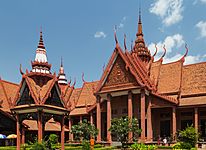 |
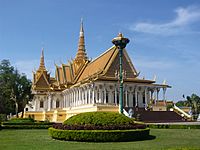 |
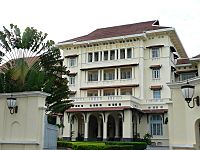 |
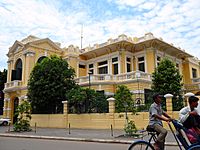 |
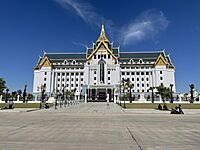 |
| National Museum, designed in the early-1920s by George Groslier. | Royal Throne Hall, constructed in the 1860s under King Norodom I. | Façade, Hotel Le Royal, built in 1929 in the reign of King Sisowath Monivong. | Colonial villa in Phnom Penh. | Ministry of Land Management, Urban Planning and Construction. |
Future City Plans
A plan for Phnom Penh's development until 2035 is in progress. This plan is supported by France. It aims to connect new city areas to the old center. This will be done with waterways and tree-lined paths.
Media and News in Phnom Penh
Daily Newspapers
Khmer Newspapers
- Sralagn' Khmer (Love Khmer)
- Chakraval Daily (Universe)
- Kampuchea Thmei Daily (New Cambodia)
- Kampuchea Tgnai Nis (Cambodia Today)
- Kanychok Sangkhum (Social Reflection)
- Koh Santepheap (Island of Peace)
- Moneaksekar Khmer (Khmer Conscience)
- Rasmei Kampuchea (Light of Kampuchea) – Cambodia's largest daily.
- Samleng Yuvachun (Voice of Khmer Youth)
- Udomkate Khmer (Khmer Ideal)
- Wat Phnom Daily (Mount Temple)
English Newspapers
- Phnom Penh Post, an English newspaper.
- The Cambodia Daily, an English newspaper (now online).
- Khmer Times, an English newspaper.
Chinese Newspapers
- 《柬華日報》(Jianhua Daily)
- 《星洲日報》(Sin Chew Daily)
- 《華商日報》(Huashang Daily)
- 《高棉日报》(Khmer Daily)
- 《新柬埔寨》(New Cambodia)
Magazines
- AsiaLIFE Guide Phnom Penh, a monthly English magazine (stopped in 2018).
- F Magazine, Cambodia's first fashion magazine. It is in English and Khmer.
- SOVRIN Magazine, a fashion magazine in Khmer.
Online News
- Thmey Thmey Phnom Penh
- Sabay News Phnom Penh
- Fresh News Phnom Penh
Sports in Phnom Penh
Martial arts like Bokator, Pradal Serey (Khmer kickboxing), and Khmer traditional wrestling are popular. Cambodia has become more involved in modern sports. Football and martial arts are especially liked.
The main sports places are the Morodok Techo National Stadium. It holds 60,000 people. It opened in 2021 and is home to the Cambodia national football team. The Phnom Penh National Olympic Stadium holds 30,000 people. It was built in 1964. Volleyball, basketball, and Tai-Kwon-Do games are often held there.
In football, Phnom Penh Crown FC is a well-known team. Other teams include Visakha, Nagaworld, and Boeungket.
The National Sports Centre of Cambodia hosts swimming, boxing, and volleyball. The city hosted the 2023 Southeast Asian Games and the 2023 ASEAN Para Games. This was the first time Cambodia hosted such a big sports event. Phnom Penh will host the 2029 Asian Youth Games.
Getting Around Phnom Penh
Phnom Penh International Airport is Cambodia's biggest airport. It is 7 kilometres (4.3 mi) west of the city center. You can get to the city by taxi, train, or shuttle bus. A new airport, Techo International Airport (Cambodia), is planned to replace it in 2025.
Cambodia's national airline, Cambodia Angkor Air, started in 2009. Its main base is in Phnom Penh.
Taxis, pick-ups, and minibuses travel from the city to other parts of the country. However, buses are becoming more popular. Phnom Penh also has a train service.
Many bus companies operate in Phnom Penh. They go to most provincial capitals. These include Sihanoukville and Saigon. Giant Ibis is another bus company. It offers free Wi-Fi and air conditioning.
The city is Cambodia's main freshwater port. It is a big port on the Mekong River. It connects to the South China Sea through a river channel in Vietnam.
Public Transportation
Phnom Penh has air-conditioned public buses. The city now has 21 bus lines. These are run by the Phnom Penh government. For private travel, people use cycle rickshaws (called "cyclo"), motorcycle taxis ("moto"), auto rickshaws ("tuk-tuk"), and regular taxis. Locals also use bicycles, motorbikes, and cars.
Train Travel
Phnom Penh Royal railway station is a train station in the city. It is near the University of Health Sciences. The station was updated and reopened in 2010.
Passenger train services between Phnom Penh and Sihanoukville started again in May 2016. They had been stopped for 14 years. As of May 2021, there are trains from Phnom Penh to other cities like Pursat and Battambang. Trains also go to Poipet, near the border with Thailand.
Major Roads
As the capital, Phnom Penh is connected to many parts of Cambodia by national highways:
| National Highway | Code | Length | Origin | Terminal | |
|---|---|---|---|---|---|
| National Highway 1 | 10001 | 167.10 km | 103.83 mi | Phnom Penh | Vietnamese Border |
| National Highway 2 | 10002 | 120.60 km | 74.94 mi | Phnom Penh | Vietnamese Border |
| National Highway 3 | 10003 | 202.00 km | 125.52 mi | Phnom Penh | Veal Renh |
| National Highway 4 | 10004 | 226.00 km | 140.43 mi | Phnom Penh | Sihanoukville |
| National Highway 5 | 10005 | 407.45 km | 253.18 mi | Phnom Penh | Thai Border |
| National Highway 6 | 10006 | 416.00 km | 258.49 mi | Phnom Penh | Banteay Meanchey |
| National Highway 7 | 10007 | 509.17 km | 316.38 mi | Skun (Cheung Prey District) | Lao Border |
In 2023, a new expressway opened. It connects Phnom Penh with Sihanoukville. China built this road.
Phnom Penh's Water Supply
Phnom Penh's water supply has greatly improved. This happened between 1993 and 2006. More people now have access to water. The quality of service is better. The city's water company, PPWSA, went from losing money to making a small profit. These improvements have won international awards. The main water sources are the Mekong River, the Tonle Sap river, and the Tonle Bassac river.
Cities that are Friends with Phnom Penh
Phnom Penh is connected with these cities around the world:
 Bangkok, Thailand
Bangkok, Thailand Beijing, China
Beijing, China Busan, South Korea
Busan, South Korea Chongqing, China
Chongqing, China Cleveland, United States
Cleveland, United States Hanoi, Vietnam
Hanoi, Vietnam Hefei, China
Hefei, China Ho Chi Minh City, Vietnam
Ho Chi Minh City, Vietnam Incheon, South Korea
Incheon, South Korea Kitakyushu, Japan
Kitakyushu, Japan Kunming, China
Kunming, China Long Beach, United States
Long Beach, United States Lowell, United States
Lowell, United States Shanghai, China
Shanghai, China Shenzhen, China
Shenzhen, China Shantou, China
Shantou, China
Famous People from Phnom Penh
- Further information: Category:People from Phnom Penh
- Tep Boprek, musician
- George Groslier, French historian and archaeologist
- Patricia Hy-Boulais, professional tennis player
- Theavy Mok (born 1963), Cambodia's first plastic surgeon
- Ieu Pannakar, film maker
- Makhali-Phâl, author
- Veth Rathana, actress
- Norodom Sihamoni, King of Cambodia
- Mu Sochua, politician
- Preap Sovath, Cambodian singer
- Phal Sophorn, champion pradal serey boxer
- Chhet Sovanpanha, musician
- Loung Ung, author
More to Explore
- Special Economic Zones of Cambodia
See also
 In Spanish: Nom Pen para niños
In Spanish: Nom Pen para niños





